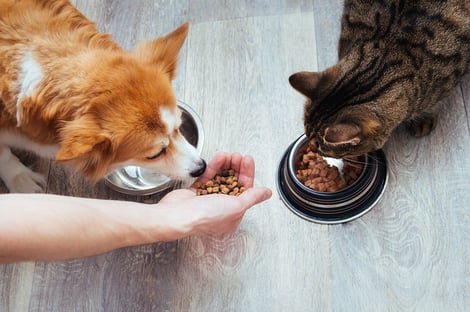Pet Food Prices Are Going Up. What’s a Pet Parent To Do?

There’s no doubt about it: Pet food prices are going up.
As pet parents, we need to feed our pets, but with today’s inflation, it’s becoming challenging for more and more families with limited budgets.
What does it cost to feed a nutritious diet to pets? And where can you turn when the cost of pet food becomes a burden?
Pet Food Costs Are Rising
Even before the post-pandemic inflation of 2022, pet food prices were going up.
This article from Tufts University School of Veterinary Medicine offers up a pre-pandemic comparison of dog food prices. They found a wide variation in prices, depending on what kind of food you choose to feed your pet.
For example, the yearly cost of feeding a 55-pound pooch ranged from $201 to more than $7,000.
Wet food is more expensive than dry, and “premium” fancy foods are more costly than supermarket brands.
The most expensive foods are freeze-dried, raw, or fresh. Not only are these foods super expensive; there is conflicting evidence about whether they are actually good for your pet.
According to Cailin R. Heinze, the veterinarian who did the comparison, a higher price does not necessarily mean your animal will be healthier. “The truth is that there are minimal scientific data to suggest a benefit of one of these diet types over others for an otherwise ‘average’ healthy dog,” she writes.
The takeaway: There is usually quality pet food that can fit into your family’s budget.
Questions: Ask Your Vet
Some dogs and cats do have specific health conditions, food allergies, or special dietary needs that should be discussed with your veterinarian.
When talking to your vet about your pet’s food, they will need to know the brand of food and the type. Telling them the size and shape of dry food or the color of the bag isn’t helpful. If you have trouble remembering, you can write it down or take a photo of the bag or can of food you feed them and bring that with you at your next visit. Also, mention anything else that your pet eats, such as “people food,” supplements, medications, and treats.
Veterinarians want what’s best for your pet, and they usually have more knowledge of nutrition than people marketing expensive foods.
Large pet food companies that work with veterinary nutritionists make great pet food. And sometimes these companies sell more affordable pet food brands because they manufacture their own pet food. These lead to better quality pet food.
Your vet can steer you to a food that is right for your pet’s needs by looking at their age, life stage, lifestyle, body weight (or body condition score), health status, and activity level.
Read the Fine Print
You can do your part by avoiding showy claims and knowing that the most important part of the label is not the fancy ingredients (animals don’t need them). If you want to know what is in your pet’s food, the Association of Animal Feed Control Officials (AAFCO) has a great resource to help you understand what the ingredient list means.
It can be tough to find, but you want to look for the AAFCO statement that says the product is “formulated to meet AAFCO standards” for the life stage of your pet: puppy/kitten, adult, pregnant, lactating (nursing puppies or kittens), or senior dog/cat.
Then you want to see if the company does actual animal feeding tests for the right life stage. Some foods say that they are used for “intermittent and supplemental” feeding. That’s not what you want to feed your pet on a daily basis.
When Feeding a Pet Is a Struggle
Because our pets are part of our families, it’s extremely difficult to experience financial circumstances that make paying for pet food too costly.
Some people love their pets so much that they skimp on their own food to buy animal food. Or they even share their food with their pets.
That’s not good. People suffer, and so do their pets. We believe that humans and pets can live happy, healthy lives together. And eating a nutritious, balanced diet for people and their pets is an essential part of that.
There are two pieces of good news on this front.
First, you don’t need to buy the most expensive food on the market. Even if it’s a big brand available at your local supermarket, it may be perfectly fine for your pet. Look for the AAFCO statement, or ask your vet.
Second, resources are available for pet parents who are having trouble making ends meet.
Help Is Available
There are organizations that run pet food pantries or programs that help low-income pet owners cover their expenses. Like most pet food pantries we know of, these tend to be limited to specific locations, have limited hours when they are open, and have limits to the kinds of pet food they can offer and how much they have in stock. There may be restrictions based on income or on whether your pet is spayed or neutered.
If people have trouble paying for pet food, then it’s highly likely they also have trouble paying veterinary bills. Some vets offer financial support to their clients in financial need. A number of clinics in Northeast Ohio accept One Health Organization Veterinary Care Vouchers. For people meeting income requirements, Vouchers provide a way to pay for important essential care such as vaccinations, medications, and check-ups, as well as help treat illnesses and provide end-of-life care.
No pet or human should go hungry (or go without access to health care). That’s why these types of programs are even more essential when inflation is rising.

